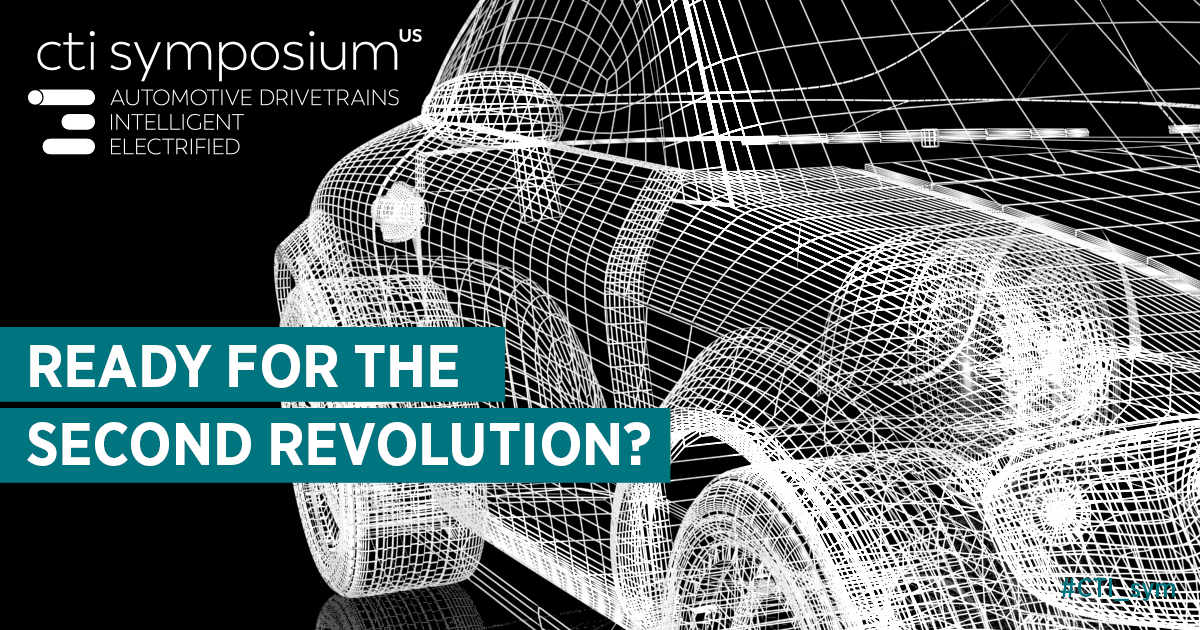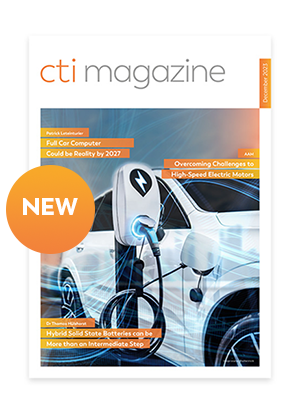
When the Tesla Roadster entered the market in 2008, it was a technological revolution. Despite widespread scepticism at the time, the discussion today is about when electric drives will supersede combustion engines. So far, however, electric vehicles are still a rare sight on the roads.
The new decade – it’s all about electromobility
The world is working on its climate-neutral future. The only way to hit increasingly ambitious CO2 targets for automobiles is by making determined efforts to electrify vehicle fleets. At the same time, electric drives have now shown they are suitable for everyday use. Ranges have been extended, charging times reduced, and tailwind is being provided by politics, the trend and the technology. The time is right for the second revolution, when electric drives conquer the roads.
Experience the thrust of progress – at CTI SYMPOSIUM USA
Take part in a contest of ideas when we present the latest technical developments over two days in eleven sessions. The 14th CTI SYMPOSIUM USA offers information straight from the horse’s mouth. Listen to top-notch experts as they present their theses in the plenum – and form your own opinions on the cutting-edge topics up for debate in the panel discussions.
Tomorrow’s electric drives – highly efficient and affordable
What compelling benefits do next-generation EDUs have to offer? The answer to that question will decide how attractive tomorrow’s BEVs will be. High efficiency is a key factor for range, while highly integrated, modular and scalable overall systems ensure low costs.
Mathias Deiml (AVL, Germany) will present a new-development EDU with a high-speed motor. By drastically increasing rpm to over 25,000 rpm, AVL were able to significantly reduce torque requirements, and hence motor weight. In addition to compact packaging, developers placed special emphasis on a motor design that minimises the use of rare earths. The most promising concepts were filtered out in a trade-off study. The final EDU is configured for voltages of up to 850 volts DC and comprises two independent wheel drives. It offers of 5000 Nm of torque, a peak output of 300 kW and torque vectoring functionality. The motors share a single housing with a dual SiC inverter and two single-speed transmissions. The project illustrates one way to combine high scalability, cost efficiency and high power density in EDUs for tomorrow’s mobility. The latest test results, which Mathias Deiml will be presenting, should be particularly interesting.
Dr Karel Vergote (Punch Powertrain, Belgium) will present a new 150kW e-drive axle development based on a holistic approach and a co-design methodology. The motor uses hybrid synchronous (HSM) reluctance technology, which typically requires 50% fewer magnets than a permanent magnet synchronous motor (PMSM) of comparable efficiency. This is important because magnet production requires rare earths, so HSM reduces supply and cost risks caused by limited availability and mining-related environmental issues. The inverter technology is based on the latest IGBT power switching devices. It is characterised by above-average volumetric power density, and supports the future use of SiC power switching elements.
The single-speed transmission achieves efficiencies of over 98%. The modular structure can accommodate three different gear ratios and a park lock device without modifications. The close integration of motor, inverter and transmission helps to optimise the system in terms of efficiency, cost and power density. Due to its compact build, the new e-Drive axle can be used for either front- or rear axle drives.
Consistent forward thinking – from individual model to vehicle fleet
To achieve the strict emission targets for 2025+, manufacturers have no choice but to launch more models with all-electric drives. René Kockisch (IAV Germany) will present a modular BEV powertrain platform that covers an entire vehicle fleet, from small A-Class cars to high-performance D-Class SUVs. Using IAV’s Powertrain synthesis methodology, developers configured the electric motors, power electronics and transmissions in a way that meets each vehicle’s performance requirements while simultaneously ensuring high-grade modularity and low costs. The modularity of the powertrain platform is based on different types and sizes of electric motors, such as synchronous and induction motors. Transmission options include single and two-speed transmissions, with or without powershift. They share as many common components as possible, and the same manufacturing tools are used across the whole platform. Additional subsystems such as a torque vectoring module or a motor disconnect device make the platform suitable for sports hybrid vehicles too. René Kockisch will give detailed insights into the design of the EV platform, and will pay special attention to the latest development trends for multi-speed transmissions. These include application-optimised e-motors and the use of electromechanical and hydraulic shift actuators.
Powertrain configuration – algorithms for optimisation
When designers consider the different elements of a drivetrain, each with their different structures, technical variants, sizes and performance characteristics, there are thousands of different possibilities. When that happens, it takes more than just knowledge, experience and intuition to find the optimal solution.
Muammer Yolga (AVL List Austria) recommends the ‘Automated BEV Powertrain Configurator’ as a powerful assistant that not only optimises individual components, but evaluates the entire e-drive system too. General criteria for evaluating both individual elements and the overall powertrain include package, efficiency, cost, performance, NVH behaviour and range. Key optimisation parameters for the various elements are type, maximum power and maximum torque (motorisation), semiconductor type and switching frequency (inverters), type, transmission ratio and number of gears (transmissions) and number of motors and axles (architecture). The automated configurator has a flexible system that supports task-specific weighting of evaluation criteria. The AVL component database is particularly useful when verifying new concepts. To round off his lecture, Muammer Yolga will address the results for BEV drivetrains currently in production, and show how these can be improved.
Participants who are interested in consistently minimising costs will be all ears when Ajay Lukha (YASA, Great Britain) presents a tool in his lecture that uses genetic algorithms. Inspired by evolution, this method uses an optimisation process based on natural selection. With the aid of these genetic algorithms, the tool shows which designs will best enable vehicle architectures, motors, inverters and transmissions to meet specified performance indicators (e.g., 0 – 100 km/h acceleration, range or top speed) at minimal BOM costs. This tool has a visible impact on the way YASA develops and refines its new EDU product family. Simulations are continuously verified, using published vehicle data. In his lecture, Ajay Lukha will propose solutions for the most cost-effective architectures and components in specific vehicle segments, again based on the most recent data from available vehicles.
Analysis and outlook – controversial market research findings
Edwin Pope (IHS Markit, USA) will speak on the weight of drive systems. Following an overview of the market situation and the corresponding forecasts, the last part of his presentation in particular promises to yield some surprising insights. One of the disruptive technologies he will address is the promising process of 3D metal printing. Another is the brand-new Hunstable Electric Turbine (HET). Can this invention drive a quantum leap in efficiency and weight reduction? You’ll know more after you hear Edwin Pope’s lecture.
In the United States, over 85% of model year (MY) 2019 powertrains with an ICE fail to meet the proposed MY 2025 standards for greenhouse gases and fleet consumption. Conversely, nearly all types of highly electrified drivetrains meet these standards. Based on that status quo analysis, the question Greg Pannone (IHS Markit, USA) will ask in his lecture is this: Given this reality, and uncertainty in the US regulatory landscape, what role will electrification (xEV) play in future? After running through various regulatory and technological scenarios up to MY 2030, Greg Pannone will analyse what role xEVs will play, and what the resulting requirements for their drivetrains will be.
The CTI SYMPOSIUM USA – where everything is electrifying
The CTI SYMPOSIUM USA with its accompanying Expo offers you up-to-date information and controversial ideas in the lectures and plenary discussions, as well in the sessions.
Welcome to CTI SYMPOSIUM USA!
